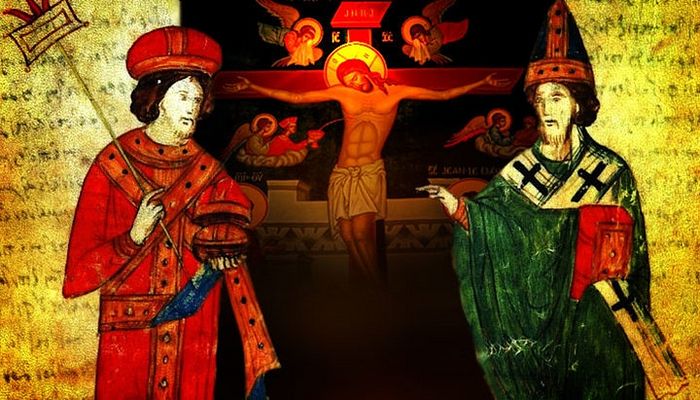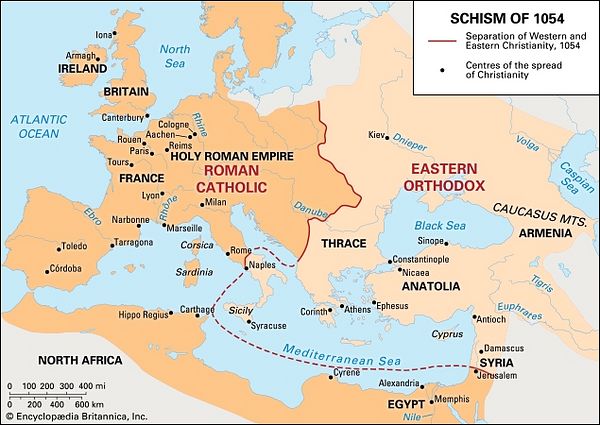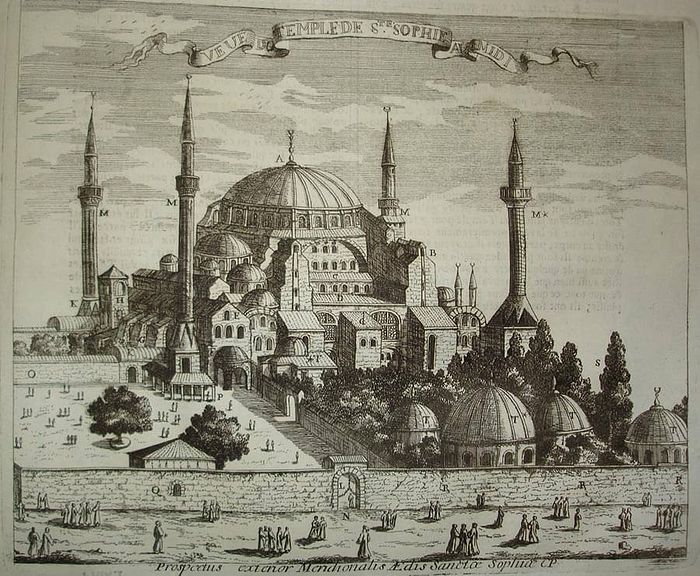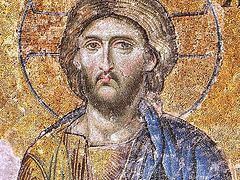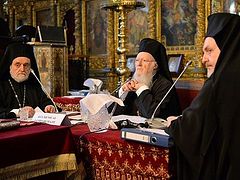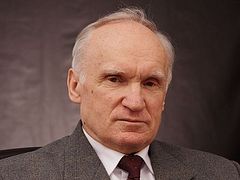On January 21, 1059, the Patriarch of Constantinople Michael I Cerularius died. In the eleventh century, this wonderful man began the battle against the claims of Papal supremacy, which led to the Great Schism of the Churches in 1054. Today we will talk about these fateful events.
Conflicts between the Eastern and Western Churches arose earlier, and more than once. The first to speak out against the pretensions of the Pope was the Holy Hierarch Photios of Constantinople, as early as the ninth century, but after that, for almost two hundred years, the warring parties found various ways for reconciliation; by the eleventh century, however, the Christian world found itself completely divided.
The first step towards a confrontation between the Churches of Constantinople and Rome [in the eleventh century—Trans.], was the fact that Patriarch Michael forbade the conducting of services according to the Roman rite in the Byzantine capital, and the dioceses subordinate to him in [Southern] Italy. This action offended the proud Pope Leo IX too much. Moreover, in his letter to his subordinate, Bishop John of Trani, Cerularius also exposed a number of Latin errors which were present in their teachings by that time.
For the sake of fairness, it must be said that the message of Patriarch Michael did not carry a strictly dogmatic nature, and it does not mention the notorious doctrine of the filioque, which Saint Photios also stood against. Cerularius accuses Western Christians of celebrating the Eucharist with unleavened bread and observing a fast on Saturday.
The most “dreadful crime”, however, was in that he was bold enough to address his letter [criticizing the Bishop of Rome] not to the Pope personally, but to an ordinary Bishop, and even more “dreadful” was that the Pope was then written by that same ordinary Bishop John of Trani, and not by the Patriarch of Constantinople privately. It’s totally clear that when Pope Leo IX found out about this letter, it caused a storm of indignation.
In response, he did not even try to somehow justify the errors that Patriarch Michael pointed out, but in a rather extensive text he declared what is already familiar to most Orthodox—the imperious pretentions to supremacy of the Roman Pontiff.
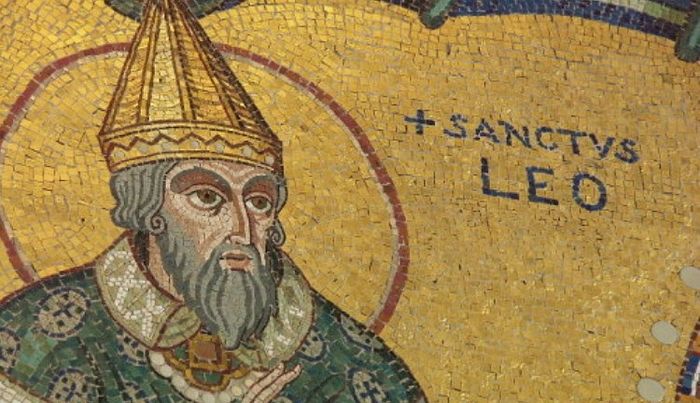 Pope Leo IX. Photo: iglesia.info
Pope Leo IX. Photo: iglesia.info
Pope Leo moreover, does not hold back on epithets rather humiliating for the Church of Constantinople, and refers to her as a “naughty” child, to whom a strict father will now teach how she must live. For clarity, we give some statements from the letter of the Roman Pontiff:
You, our beloved, yet still condemned brother in Christ, and Primate of Constantinople, with unprecedented audacity and unheard-of boldness, dared to judge the clearly apostolic, Latin Church ... Here is your imprudent scolding, here is your ugly boastfulness, when you, believing that your mouth is in heaven, in essence are crawling across the earth with your tongue ... If you do not come to your senses, you will find yourself on that tail of the (apocalyptic) dragon, with which that dragon knocked down one third of the stars of heaven, and plunged them to earth.
Then came the classic argument of why the Roman Church cannot be judged by anyone else, and is the leader of all other Churches. Interestingly, in addition to referring to the words of Christ: You are Peter, and on this rock, I will build My Church (Mat. 16:18), Pope Leo, in another attempt to justify his authority, points to the position of the body of the crucified Apostle Peter. Thus, according to the Pontiff, the Apostle was crucified upside down, as if he bowed his head in order to bring it closer to the cornerstone—the Savior, and so that all the other members of the Body of Christ would be erected on it in Heaven.
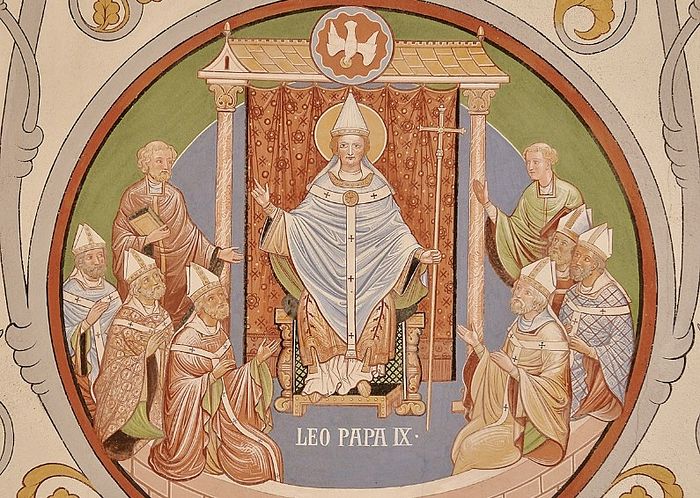 Pope Leo IX. Photo: vokrugsveta.ru
Pope Leo IX. Photo: vokrugsveta.ru
But the originality of the Pope does not end there, and he goes even further. Leo IX says that the Apostle Peter possessed the gift of such miracles as were not even performed by Christ, citing the fact that even his shadow healed people. It must be said that the eleventh century did not reveal anything original in the papal pretensions that manifested themselves quite earlier, but the tricks that we examined were original. Pope Leo gave a number of other arguments, but they are all well known, and you can find them in any textbook on comparative theology, but the main conclusion can be reduced to the following words: "The first seat1 will not be judged by anyone.”
The Pope moreover, does not confine himself to purely ecclesial authority, and claims that Emperor St. Constantine the Great granted the Roman Throne also temporal (secular) authority which surpasses the authority of all earthly kings.2 He further claims that Emperor Constantine donated various riches to his contemporary Pope St. Sylvester I, and personally wanted to lay his crown on his head, but he refused the crown of gold, and instead received the Phrygian imperial crown3, and in addition, a crimson tunic, a [tyrian] purple mantle, papal vestments, and the royal scepter.
It was all described with such passion and arrogance that it makes you think the Emperor may just well have given the Pope his wife and children, and went on retirement!
In general, in his letter, Leo IX did everything possible to try and make Patriarch Michael of Constantinople feel how insignificant his role in the Christian world was, and that he should not even think of putting himself on the level of Rome. So much for the Gospel approach.
But let's go back to historical events, and note that even before writing this letter, Pope Leo entered into relations with the Byzantine Emperor Constantine IX Monomachos for purely political reasons. The fact is that the Greek regions in Italy suffered oppression from the Normans, and it is clear that they did not give any rest to the Roman Pontiff either. For this reason, Emperor Constantine Monomachos, with the support of the Pope, wanted to persuade the German King Henry III to enter an alliance and joint war against these very Normans.
In order to settle these plans, a papal envoy was sent to Constantinople, whose tasks included, in addition to political ones, reconciliation with Patriarch Michael, naturally on conditions favorable to Leo.
This endeavor failed to achieve any of its goals. The Roman ambassadors brought two letters with them—one to the emperor, the other to the Patriarch. For obvious reasons, we will not touch on the political side. It is quite natural to expect that Pope Leo did not change his position, and his new letter again abounds with a whole bundle of humiliating maxims for the Cathedra of Constantinople.
Among other things, the Pope here accuses the Patriarch of unreasonable claims to power over all the Eastern Churches, is outraged by [Pat. Michael’s] idea that the leading Sees should coordinate their actions with each other on the most important issues, and thus achieve concord, and also [accused Pat. Michael] of wanting to rule over the entire Christian Ecumene.
However, in spite of the arrogant tone of the letter, it was believed that everything was [about to be] somehow resolved, if not for the disgusting and frankly reckless behavior of the Papal legates.
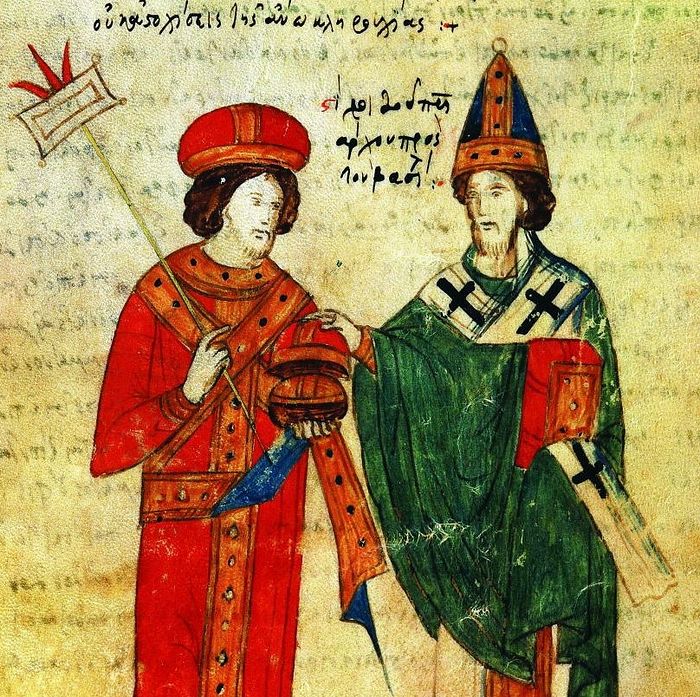 Pope Leo IX and the Patriarch of Constantinople Michael I Cerularius. Photo: tunnel.ru
Pope Leo IX and the Patriarch of Constantinople Michael I Cerularius. Photo: tunnel.ru
The head of the Roman embassy in 1054 was Cardinal Humbert, whose character historians describe as passionate and cantankerous, and moreover, he was an ardent fighter for the primacy of the Papal Cathedra. With such a person at the head, the hope for a somewhat shaky peace, and the opportunity to come to agreement was lost even before he entered the Byzantine capital.
In Constantinople, Cardinal Humbert behaved as if the whole Greek Church was already subordinate to Rome, and as if he were some kind of judge whom even the Patriarch must submissively obey. Despite such defiant behavior, to the honor of Patriarch Michael, it must be said that he did not return a single insulting remark to the Roman embassy, but simply retired from any negotiations with them. He understood that the slightest concessions to the Papal legates would be tantamount to recognizing the supremacy of power of the Roman Pontiff, and trying to engage in discussions with people like Cardinal Humbert was completely pointless.
The position of Patriarch Michael greatly irritated the Roman embassy, which prompted them to commit the shameful act—pronouncing an anathema on the Church of Constantinople.
On July 16, 1054, they boldly burst into Hagia Sophia during the service and dropped a letter of excommunication [against Patriarch Michael] right on the altar.
The response was not long in coming.
Already by July 20, Patriarch Michael convened a council, which includes the following statement:
Some ungodly people came from the darkness of the West to the kingdom of piety and into this God-protected city, from which the waters of pure doctrine flow as if from a fountain to the ends of the earth. They came to this city like thunder, or a storm, or a glade, or better, like wild boars, to overthrow the truth.
And here it must be noted clearly that two features of Patriarch Michael’s actions qualitatively distinguish him from those of the Roman legates:
-
To solve the problem, he resorted to conciliar, and not personal authority.
-
The anathema pronounced by the Council does not apply to the entire Roman Church, but only to the legates and persons associated with them.
This exchange of anathemas was the starting point for the final division of the Christian world into East and West. At that time, no one could have thought that this schism would never be healed. And although in nearby history, we saw no more conflicts between the Churches of Constantinople and the Rome, this division, however, only increased.
Patriarch Michael was a worthy man, and found the only right way out of this difficult situation. But God grant us understanding in order to learn the lessons of history and learn from such people as the Patriarch of Constantinople Michael I Cerularius.

